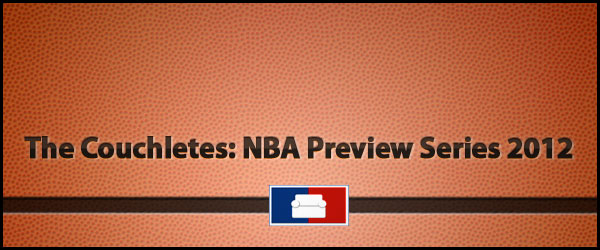This post continues our 2012-2013 NBA Preview. You can view all our NBA preview posts here.
Many people talk about parity in the NFL and how great it is for the sport. Every year, each team (for the most part) has a shot (some being long shots) at the playoffs. For the most part, I see the truth in that, but Cleveland Browns fans might disagree with me. I don’t buy into this parity talk as much as some people. There are certain teams we know will just be bad. However, I do think the NFL has evolved into a league where a team can turn things around relatively quickly. You don’t see teams laboring at the bottom of the cellar with no hope for years and years (sorry, Cleveland, I’m overlooking you for this post).
Baseball isn’t talked about as much as being a parity driven league because it doesn’t have a salary cap. So teams like the Yankees, Red Sox, Dodgers, Cubs and all the other wealthy, big market teams can spend at will to build contenders year after year. Yet, we don’t see that happening. The Red Sox were horrible this year and the Cubs are more often horrible than not. And we’ve seen a number of low spending, small market teams contend over the past couple years. Tampa, Oakland, Cincinnati. The Nationals were a team that had been dreadful since re-establishing as a franchise, but had the best record in the bigs this year while not spending exorbitant amounts of money. Teams like Pittsburgh, Milwaukee and Cleveland were teams that were in contention at various points of the year.
In the NBA, we don’t see this type of parity. There are a few really good teams, a few really bad teams and a mess of teams in the middle in a category many would call hopeless. They’re not good enough to contend as built, but aren’t bad enough to get a lottery pick and start to build younger, better pieces. The general thinking is you want to be really good or you want to be really bad (so you can get good in a couple years).
There’s a problem with this thinking though. It’s not that simple to rebuild through the draft anymore. Players coming out of college are less developed than in past years because they’re younger. It takes a little longer for them to adjust to the NBA and reach their true potential than it did rookies ten years ago. Many teams won’t wait around for a player to reach that potential. They give them three years and then move on, so another team ends up getting the benefits from that player’s talent and potential (see: Michael Beasley, Hasheem Thabeet, Adam Morrison, Devin Harris, etc.). Along these same lines of thinking, the job of the NBA general manager is getting more difficult. They need to find players that will contribute in the near term, but they also don’t want to miss out on that guy that develops and emerges as a viable star in his fourth year in the league.
Evidence? Look at the teams that finished near the bottom of the league last year. Charlotte’s been bad for a while. Cleveland’s been bad ever since LeBron left town. Sacramento and Golden State have been consistently poor over the past five years. Detroit, New Jersey and Toronto have been in the bottom third of the league for years as well. Each of these teams have young players they can build around, but how long will it take them to get to the point where those players can contend with the Kevin Durants, Dwight Howards and Dwyane Wades of the league? Or will they ever even get to that point?
It’s a difficult situation to fix because while the NBA has a salary cap, many of the game’s top players are now deciding that they’ll accept less salary in order to play with other great players for a chance at NBA Championships. Who would look at Sacramento or Detroit and decide they want to go play there? How does a team put itself in position to be one of the franchises that people want to go to?
They could go in a different direction than the draft and build the pieces first and then go after the star. However, teams like Houston have tried to do that and failed. Stars want to join stars. So it seems teams will be forced to continue to build through the draft. No easy solution exists to bring the kind of parity we see in football and baseball to basketball.
With that, I’ll move on to making my predictions for the good, the bad and the hopeless this year.
The Good
Miami Heat, Los Angeles Lakers, Oklahoma City Thunder, Boston Celtics, San Antonio Spurs
The Bad
Cleveland Cavaliers, Detroit Pistons, Sacramento Kings, Charlotte Bobcats, New Orleans Hornets
The Hopeless
New York Knicks, Brooklyn Nets, Philadelphia 76ers, Toronto Raptors, Indiana Pacers, Milwaukee Bucks, Chicago Bulls, Atlanta Hawks, Orlando Magic, Washington Wizards, Portland Trailblazers, Denver Nuggets, Utah Jazz, Minnesota Timberwolves, Los Angeles Clippers, Phoenix Suns, Golden State Warriors, Memphis Grizzlies, Dallas Mavericks, Houston Rockets
Not surprisingly, the Hopeless category has the most teams in it…
By Kevin York
Follow Kevin on Twitter at @kevin_york


